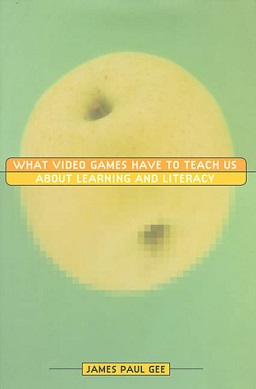Semiotics is the systematic study of sign processes (semiosis) and meaning making. Semiosis is any activity, conduct, or process that involves signs, where a sign is defined as anything that communicates something, usually called a meaning, to the sign's interpreter. The meaning can be intentional, such as a word uttered with a specific meaning; or unintentional, such as a symptom being a sign of a particular medical condition. Signs can also communicate feelings and may communicate internally or through any of the senses: visual, auditory, tactile, olfactory, or gustatory (taste). Contemporary semiotics is a branch of science that studies meaning-making and various types of knowledge.
Gameplay is the specific way in which players interact with a game, and in particular with video games. Gameplay is the pattern defined through the game rules, connection between player and the game, challenges and overcoming them, plot and player's connection with it. Video game gameplay is distinct from graphics and audio elements. In card games, the equivalent term is play.
Video game design is the process of designing the content and rules of video games in the pre-production stage and designing the gameplay, environment, storyline and characters in the production stage. Some common video game design subdisciplines are world design, level design, system design, content design, and user interface design. Within the video game industry, video game design is usually just referred to as "game design", which is a more general term elsewhere.

Katie Salen Tekinbas is an American game designer, animator, and educator. She is a professor at the University of California, Irvine. Previously, she taught at DePaul University College of Computing and Digital Media, Parsons The New School for Design the University of Texas at Austin, New York University, and the Rhode Island School of Design. She has an MFA in graphic design from the Rhode Island School of Design.

Eric Zimmerman is an American game designer and the co-founder and CEO of Gamelab, a computer game development company based in Manhattan. GameLab is known for the game Diner Dash. Each year Zimmerman hosts the Game Design Challenge at the Game Developers Conference. He is also the co-author of four books including Rules of Play with Katie Salen, which was published in November 2004. Eric Zimmerman has written at least 24 essays and whitepapers since 1996, mostly pertaining to game development from an academic standpoint. He's currently a founding faculty at the NYU Game Center.
A pervasive game is one where the gaming experience is extended out in the real world, or where the fictive world in which the game takes place blends with the physical world. The "It's Alive" mobile games company described pervasive games as "games that surround you", while Montola, Stenros and Waern's book, Pervasive Games defines them as having "one or more salient features that expand the contractual magic circle of play spatially, temporally, or socially." The concept of a "magic circle" draws from the work of Johan Huizinga, who describes the boundaries of play.

In games and digital media, the "magic circle" is the space in which the normal rules and reality of the world are suspended and replaced by the artificial reality of a game world. As noted by Edward Castronova in Synthetic Worlds: The Business and Culture of Online Games, the boundary delineating this space "can be considered a shield of sorts, protecting the fantasy world from the outside world". Instead of being impenetrable, however, an examination of contemporary virtual worlds reveals that the magic circle is actually quite porous. More directly, there appears to be a relationship between virtual worlds and the outside world.

A game is a structured form of play, usually undertaken for entertainment or fun, and sometimes used as an educational tool. Many games are also considered to be work or art.
Nicholas Fortugno is an American game designer and educator. Fortugno is CCO of Playmatics LLC, a New York City-based game development studio focusing on casual games and co-founded with Margaret Wallace.
Meaningful play are actions or activities built with either a designed or inherent intent, such as data collection or therapy.

Gearheads is a strategy video game developed by R/GA Interactive and Philips Media, and published by Philips Media for Microsoft Windows and Mac OS in June 1996. The player deploys wind-up toys to get them across an arena while attempting to prevent toys from crossing from the other side. Players can play against the computer or another player. Single, customisable games can be played, or the player can play a series of games with set rules and a limited number of lives in a tournament.
The lusory attitude is the psychological attitude required of a player entering into the play of a game. To adopt a lusory attitude is to accept the arbitrary rules of a game in order to facilitate the resulting experience of play.

James Gee is a retired American researcher who has worked in psycholinguistics, discourse analysis, sociolinguistics, bilingual education, and literacy. Gee most recently held the position as the Mary Lou Fulton Presidential Professor of Literacy Studies at Arizona State University, originally appointed there in the Mary Lou Fulton Institute and Graduate School of Education. Gee has previously been a faculty affiliate of the Games, Learning, and Society group at the University of Wisconsin–Madison and is a member of the National Academy of Education.
The semiotics of social networking discusses the images, symbols and signs used in systems that allow users to communicate and share experiences with each other. Examples of social networking systems include Facebook, Twitter and Instagram.

An art game is a work of interactive new media digital software art as well as a member of the "art game" subgenre of the serious video game. The term "art game" was first used academically in 2002 and it has come to be understood as describing a video game designed to emphasize art or whose structure is intended to produce some kind of reaction in its audience. Art games are interactive and the result of artistic intent by the party offering the piece for consideration. They also typically go out of their way to have a unique, unconventional look, often standing out for aesthetic beauty or complexity in design. The concept has been extended by some art theorists to the realm of modified ("modded") gaming when modifications have been made to existing non-art games to produce graphic results intended to be viewed as an artistic display, as opposed to modifications intended to change game play scenarios or for storytelling. Modified games created for artistic purposes are sometimes referred to as "video game art".

Gamelab was an independent game studio in New York City, New York founded by game designer Eric Zimmerman and Peter Seung-Taek Lee in 2000. It is best known for creating Diner Dash, one of the most downloaded games of all time, as well as its two spin-off companies, the non-profit Institute of Play and the online game and community site Gamestar Mechanic.

What Video Games Have to Teach Us About Learning and Literacy is a book by James Paul Gee that focuses on the learning principles in video games and how these principles can be applied to the K-12 classroom. Video games can be used as tools to challenge players, when they are successful. They motivate players to persevere and simultaneously teach players how to play the game. These games give a glimpse into how one might create new and more powerful ways to learn in schools, communities, and workplaces. Gee began his work in video games by identifying thirty-six learning principles that are present in—but not exclusive to—the design of good video games. He further argues for the application of these principles into the classroom environment. What Video Games Teach Us about Learning and Literacy is a call to educators, teachers, parents and administrators to change the approach to pedagogy.

Game design is the process of creating and shaping the mechanics, systems, and rules of a game. Games can be created for entertainment, education, exercise, or experimental purposes. Increasingly, elements and principles of game design are also applied to other interactions, in the form of gamification. Game designer and developer Robert Zubek defines game design by breaking it down into its elements, which he says are the following:
Procedural rhetoric or simulation rhetoric is a rhetorical concept that explains how people learn through the authorship of rules and processes. The theory argues that games can make strong claims about how the world works—not simply through words or visuals but through the processes they embody and models they construct. The term was first coined by Ian Bogost in his 2007 book Persuasive Games: The Expressive Power of Videogames.
Games and learning is a field of education research that studies what is learned by playing video games, and how the design principles, data and communities of video game play can be used to develop new learning environments. Video games create new social and cultural worlds – worlds that help people learn by integrating thinking, social interaction, and technology, all in service of doing things they care about. Computers and other technologies have already changed the way students learn. Integrating games into education has the potential to create new and more powerful ways to learn in schools, communities and workplaces. Games and learning researchers study how the social and collaborative aspects of video game play can create new kinds of learning communities. Researchers also study how the data generated by game play can be used to design the next generation of learning assessments.










